
9 minute read
HIGH PERFORMANCE HVAC Finding balance

BALANCE BALANCEFINDING FINDING
Advertisement
At the risk of sounding obsessed with ventilation t the risk of sounding obsessed with ventilation specifically and HVAC design generally, I will admit that whenever I pull on the front door of a restaurant, I pause to notice if I am pulling against the negative pressure of the kitchen exhaust fan. If there is a big woosh of air, I question whether there has been a proper kitchen exhaust design completed, or if the building owner is just trying to avoid heating and cooling costs of operating a make-up air system.
If there is no woosh of air, I imagine either they have a wellbalanced air make up system or that the kitchen workers may be experiencing less than ideal air quality due to inadequate exhaust. It might seem obvious, but I find some building owners or operators and the odd HVAC contractor tend to forget the basic physics that air out always equals air in. Proper HVAC design must consider keeping an appropriate balance across the building enclosures.
Consider why maintaining this balance is important: physics dictates that whatever amount of air you need or want to exhaust out to control pollutants from cooking, welding fumes, vehicle exhaust or any other applications, the same amount of air needs to come in to replace it. If there isn’t sufficient replacement air, referred to in codes and standards as “makeup air,” a negative pressure will be induced on the building enclosure itself, and subsequently on the exhaust fan.
This has important ramifications: First and most importantly, other appliances in the building susceptible to negative pressures will be impacted. Always consider the combustion safety impacts of large capacity

OVERCOMING BUILDING PRESSURE OVERCOMING BUILDING PRESS

The National Building Code of Canada, and all provincial codes, express it this way:
6.2.3.11. Makeup Air
In ventilating systems that exhaust air to the outdoors, provision shall be made for the admission of a supply of makeup air in sufficient quantity so that the operation of the exhaust system and other exhaust equipment or combustion equipment is not adversely affected.
exhaust fans in buildings. Professional HVAC contractors will recognize the back-drafting potential of natural draft combustion appliances. In the absence of a specification from the manufacturer of the combustion appliance and venting system, a 5 Pascal negative pressure limit should be considered safe.
Next, in the absence of a specific make-up air duct or pathway, the building enclosure will be subjected to a negative pressure. The magnitude of that pressure will be dependent on the air leakage characteristics of the building enclosure, that is, how tight is the building? In order to maintain the desired exhaust capacity for the application, the fan system will have
Gord Cooke Gord is a professional engineer who has spent 20 years helping builders and HVAC contractors implement innovative technologies into high-performance homes. He has particular expertise in IAQ and airflow management in houses, and can be contacted at gordc@buildingknowledge.ca.
OPTIMIZE AIR OUT COMPONENT
Consider an application for an existing restaurant where some telltale symptoms of inadequate makeup air have been identified: a smoky kitchen, cold drafts and doors slamming shut. There are opportunities here to optimize performance and cut capital and ongoing operating costs, using that same physics principle: air in equals air out.
The performance of a kitchen exhaust hood is best described by its capture effectiveness: what percentage of the pollutants that come off the stove top are captured by the hood? Fortunately, there are industry guidelines and standards that help define and optimize this performance. Standards such as, NFPA 96 “Ventilation Control and Fire Protection of Commercial Cooking Operations,” ASTM Standard F-1704, “Test Method for
capacity for the application, the fan system will have to overcome the building pressure it just induced, in addition to the resistance of the duct, fittings and termination hood.
As noted above, the pressure limit in buildings with natural draft combustion products prone to backdrafting is -5 Pascal (0.2 inch of water column). In the absence of a combustion spillage concern, my experience has been that building enclosure pressures of more than -25 Pascal (0.1 inch of water column) result in those annoying drafts, hard to open doors and transfer of odours. Moreover, if you check the fan specifications, you may see that at -25 Pascal (0.1 inch of water column), the exhaust fan capacity may start to fall.
Clearly, a simple approach in a new application is to match the design capacity of the air makeup system with the design capacity of the exhaust system, and then adjust flows once installed to ensure the actual matches the design intent.
For safe, effective and efficient operation of large capacity exhaust systems, professional HVAC contractors should be measuring building enclosure pressures and properly matching makeup air systems to maintain the proper balance pressures.
Performance of Commercial Kitchen Ventilation Systems,” and UL 710 “Standard For Exhaust Hoods For Commercial Cooking Equipment.”
The performance is related to the exhaust hood geometry, the distance of the cooktop to the air intake grille, and of course the exhaust capacity, which is usually expressed as the volume of air per square foot (CFM/ft2) of the open space area of the exhaust hood, or in some standards it is expressed as volume per lineal foot (CFM/ft). In an existing application, simple changes such as the addition of side panels to the capture hood, or adjusting the supply air grilles, can improve performance by eliminating cross drafts. Be sure to check with the appropriate authorities and the manufacturer of the hood to ensure proper fire protection has been maintained. The type of cooking equipment and food being prepared also impact design. For example, cooking that produces smoke and grease requires specific fire suppression and liquid tight construction. It is useful to know that optimizing the performance of a kitchen exhaust system can cut exhaust requirements by up to half for the same capture effectiveness of a poorly designed system. This is an important opportunity you can present to clients.

Once the exhaust capacity has been optimized, a simple pressure measurement can be taken between inside and outside the building enclosure, using a digital pressure gauge while the exhaust system is operating at either peak or normal operation. If that pressure exceeds the -5 Pa level, then makeup air is necessary if there are spillage susceptible combustion appliances. While makeup air is recommended to keep the building in balance in all cases, a slight negative pressure is acceptable in certain settings. If the air volume of the installed and operating exhaust system is known, that volume can be used to size the makeup air.
Of course, it may also be possible to measure the exhaust fan flow either at the open face of the hood or at the exhaust outlet on the exterior. This isn’t always practical, so for a smaller application where the fan flow is expected to be under 5,000 to 10,000 CFM, there is another technique to measure the exhaust flow. Employ a “blower door,” the same equipment used to measure the air tightness of residential and commercial buildings.
First measure and take note of the pressure across the building with the exhaust system running. Then install the blower door fan system in an entry door. Turn the blower door fan up until the pressure across the building gets below -5 Pa (or whatever limit you are hoping to achieve). The measured flow through the blower door system is the capacity you will need from a makeup air system.
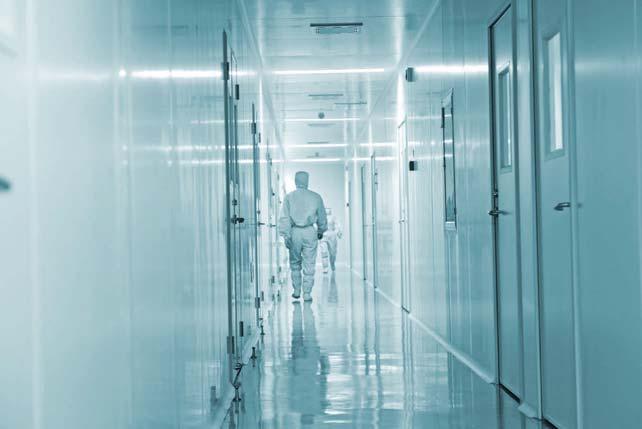
Issues with negative pressure
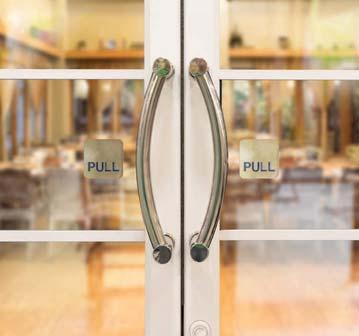
Consider the impacts or annoyances caused by negative pressure on the building itself. A restaurant isn’t very welcoming if patrons struggle to open the front door, or if there is an icy draft through windows and under doors near patrons’ tables. Similarly, in a welding shop, or other commercial and industrial applications with large exhaust air requirements, managing temperatures and even humidity levels can be a challenge if make-up air is provided simply through the building enclosure. Imagine the odour complaints in a retail plaza if the exhaust fans from a hair salon are inducing air leakage through the demising wall of a neighbouring pet shop.
WHEN IS NEGATIVE A POSITIVE
There are certainly applications where a negative pressure across a building enclosure, or part of a building, is desirable. “Clean” rooms, smoking rooms and treatment or isolation rooms for infected people (such as we are experiencing with COVID-19), are applications where a consistent negative pressure is appropriate. Even in these spaces, pressures in the order of -5 to -10 Pascal are typically specified. This means we have a clear understanding that proper HVAC design for applications with large exhaust capacity would require consideration for a makeup air system. A system should be sufficient to ensure the building enclosure is not subjected to more than -5 Pascal (if the application included spillage susceptible combustion appliances), and certainly no more than -25 Pascal in all other typical applications.
DCV DEVICES OFFER ENERGY SAVINGS
Recently, helpful new controls have been developed for commercial exhaust hoods. Referred to as demand controlled ventilation (DCV), these devices use optical and heat sensors to detect smoke and heat across the face of a range top, and adjust exhaust capacity accordingly to manage capture effectiveness. While a makeup air system would have to be designed to the peak capacity, most DCVs are capable of sending output signals to the makeup air device to simultaneously adjust its flow rate, assuming it has variable speed fan capabilities. These types of controllers can have a significant impact on annual energy costs for restaurant owners, while optimizing comfort and air quality for the professional cooking staff. Case studies provided by Enbridge Gas demonstrate return on investment potential of less than a year and a half. For more information visit: enbridgesmartsavings.com.
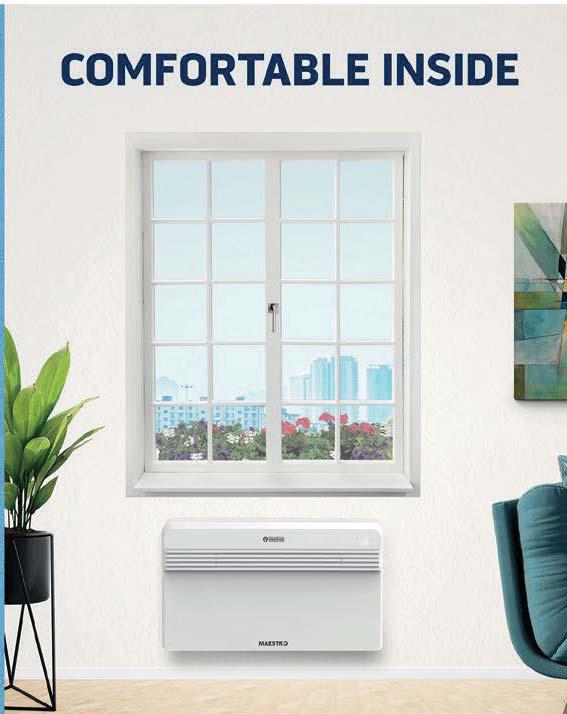

A/C & Heat Pump with no outdoor unit!

Unit Rep lacementYEAR
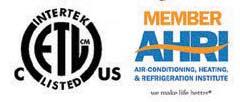
W A R R A N T Y
YEARs COMPRESSOR W A R R A N T Y
YEARs PARTS
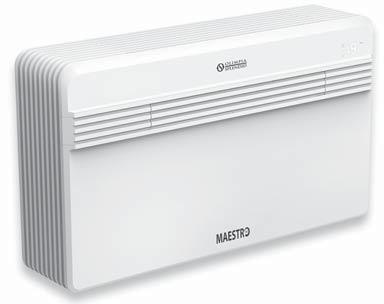
Features:
• Inverter Compressor and Variable Speed Motor • Heating & Cooling Capacity up to 11,600 btu/h • Installation Versatility: Low and High Wall • Easy Installation & Maintenance • Remote Control (standard)/ Wall Thermostat (optional) • 115V 1 Phase Power • Whisper Quiet Operation









